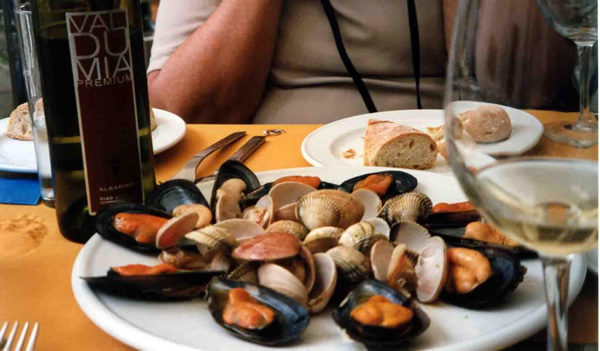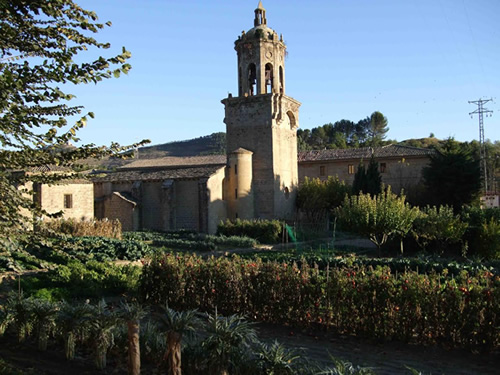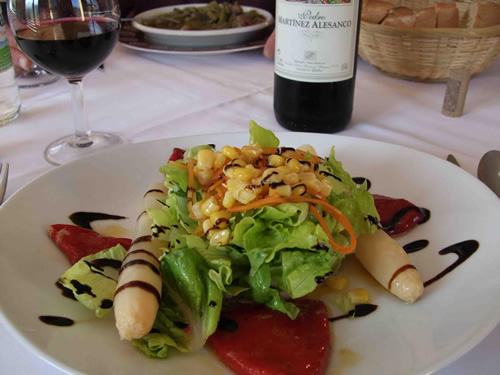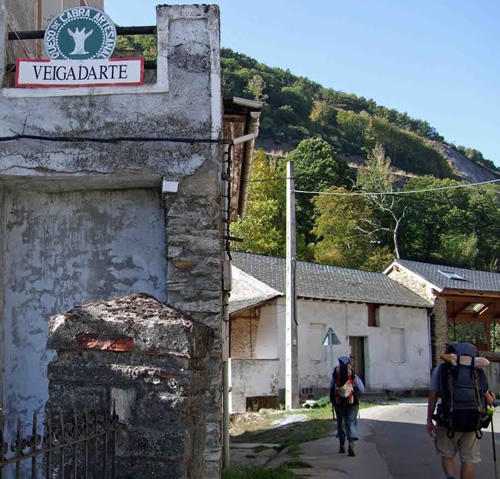Culinary Treats on the Trail to Santiago de Compostela, Spain
Nourish Your Spirit and Body
Article and photos by Beebe Bahrami

|
|
Enjoying fresh shellfish in Santiago de Campostela.
|
The Camino de Santiago
I walked the Camino de Santiago, the great pilgrimage from the Middle Ages that crosses from France over the Pyrenees into Spain and continues along the north of the Iberian Peninsula to Santiago de Compostela. As much as I walked it for the mix of physical challenge and spiritual upliftment, I was always struck by everyday life's details. Walking the pilgrim's road slowed the experience for the better. Where I spent a whole day walking 19 miles/30 kilometers, locals in their cars covered the same distance in 25 minutes. It amazed me how much I saw when that little distance was stretched out over a full day on foot.
I was struck by the microcultures of food and wine I encountered along the way. I walked through countless farmlands, vineyards, and kitchen gardens. And more delightful, at the end of each hard day of walking with my pack, I would arrive at a village where those same crops, vines, and herbs I'd just walked past were transformed into local vintages and meals I enjoyed each evening. It was a terrific reward for a long day of physical effort. It was a walking feast, a meandering Slow Food movement spread across northern Spain. It was the ultimate way to travel for pleasure, yet a food and wine pilgrimage that benefited my body and soul.
There are actually several Camino routes through Europe and Spain. Some come up from Portugal or southern Spain, others from the Mediterranean, another hugs the northern Atlantic coastline, and yet another arrives by ship and picks up the footpath in Galicia, Spain's northwestern province. But the most popular pilgrimage road to Santiago by far is the Camino Frances, the French Road, and it is the one we will cover in this story.
The Camino Frances in Spain begins in Roncesvalles. All along the way, the footpath, bike trail, or car access, depending on your transport of choice, is marked with stylized yellow scallop shells, yellow arrows, or signs with words marking the location of the pilgrimage road. A big part of the pilgrimage, especially if you walk it, is in reading the signs well and arriving at night in or near your desired destination.
The Camino Frances in Spain is like a parentheses of mountains around a tableland. You first enter through the Pyrenees, a great climb up and over the mountain pass to Roncesvalles. You then pass through several hilly landscapes through Navarra and Rioja, dotted with crops and vineyards in their unique soils. When you enter Castilla y León, you pass through a spirited and enchanting final stretch of mountains and forest, the Montes de Oca. When you are in San Juan de Ortega, just east of Burgos, the vast, flat meseta opens up and becomes your companion until you get past León in the west.
This stretch of big sky and the limitless horizon is sometimes the most potent for pilgrims. Deceptively monotonous at first, after all the mountains and hills you have experienced, the lack of distraction soon takes you deeper into your soul. In culinary terms, it is anything but boring: this is the land of grass-fed sheep, goats, and cows whose milk makes for beautifully crafted cheeses (and who themselves, for meat lovers, turn into roasted delicacies so famous in Castile). This is also the land of several Castilian wines whose unique terroir announces itself best with a roasted meat or vegetable dish.
On the western edge of Castilla y León, around Astorga, the hills and mountains begin again, leading into Galicia, a green, rainy province entirely of mountains and cliff-drop coastline. These mountains have different moods, energy, soil, and growing patterns. Many people feel they are lost in a mythic Celtic green world here.
While I strongly recommend walking the Camino as a spiritual focus, whether you are agnostic, Catholic, or a nature venerator, I invite you to savor the feast unfolding before you. Below is an overview of the food and wine highlights in each region through which the Camino passes. Each region possesses unique rural, agricultural, and viticultural artistry.
As for lodging, you have many options. You can be like many pilgrims and get yourself a pilgrim's credential or passport ahead of time (such as through Friends of the Road to Santiago), or ask for one at your starting point, such as St Jean-Pied-de-Port, a very common starting point just over the Pyrenees in France. This opens up the world of state-run and privately run albergues pilgrim's dormitories. Some have new bunks and terrific kitchens for group cooking and meals. Others are just a place to crash. All have rules about when you can check in and when you must check out.
But I confess, I am a fan of rural hotels. In León, I met a French couple who, like me, wanted to be challenged by the walk and enjoy the culinary gifts of each region. They were staying in rural hotels (called a casa rural, centro de turismo rural, or hotel rural) that are usually family-run and in old stone farmhouses turned into Bed & Breakfasts. These often run from 25-50 euros a night for a double and are still economical, though not compared to the 3-6 euros a night of the albergues. But from a culinary standpoint, they are a whole other experience. Usually, as a part of the rural hotel's package, there is a locally procured and cooked meal. This is the best way to taste those crops and vineyards you've just walked through, handled, and prepared by the people who've grown them.
Wandering Through Food and Wine on the Camino by Region
Navarra

|
|
Pilgrim church and kitchen garden in Puente la Reina, Navarra.
|
The Camino in Navarra passes through Roncesvalles, Pamplona, Puente la Reina, Estella, the Monastery of Irache (with its fountain flowing with monastic wine as a reward to pilgrims for making it this far), Torres del Rio, and Viana. The terrain goes from the mountain pass of the Pyrenees to rolling hills of vineyards and wheat fields. Common views are kitchen gardens with rows of staked tomatoes, red peppers, and large green leafy vegetables such as mustard and turnip greens.
Navarra is a mix of Basque and French influences. Trout, from the region's many rivers, is a favorite here. Navarrese especially likes to prepare their trout stuffed with slices of jamon Serrano — that Prosciutto-like-but-nuttier succulent cured Spanish pork — before putting it on the grill to cook and crisp. Navarrese also loves their local vegetables, such as red peppers, asparagus, artichokes, and green beans. These often turn up roasted with olive oil, garlic, and lemon, or menestre de verduras, a great mix of vegetables sautéed together in oil and garlic. More often than not, a slice of jamon Serrano sits atop the vegetables when brought to the table.
The grape varieties you walk past in Navarra include Tempranillo, Garnacha, Graciano, Mazuelo, Merlot, and Cabernet Sauvignon for red wines and Viura, Garnacha Blanca, and Chardonnay for white wines. Around Puente la Reina, especially the vineyards of neighboring Obanos, are some genuinely exceptional reds. On my evening in Puente la Reina, I asked the waitress to uncork the best local vintage the rural restaurant had. She returned with Viña Orvalaiz, a velvety, full-bodied red whose fruit and mineral notes tasted like the sunshine and earth I'd soaked up on my walk that day through vineyards and red pepper fields.
Bodegas Irache maintains the pilgrim's fountain near the old Cistercian monastery of Irache on the Camino just outside Estella. There, you can choose between a moderate measure of wine or a good helping of fresh water from the winery's fountain. The miraculous juxtaposition of water and wine, with echoes of Jesus' first miracle, delights many. You do not need to be religious, though, to take a sip; you can simply be a pilgrim.
Rioja

|
|
Lunch, first course, after walking in San Millan in Rioja.
|
As you cross the provincial line from Navarra to Rioja on the Camino, something fun happens. The footpath turns from gray to the color of wine. This border line is near Rioja's provincial capital, Logroño. So, the entire walk into the city is a wine-colored asphalt footpath. In Logroño and nearly everywhere you go in Rioja, wine-colored tiles, grape-shaped engravings, wine glasses, grape leaves, wine, and Bacchus himself are ever-present symbols reminding you that you have arrived in Spain's most famous wine region.
Moreover, the pilgrimage road in Rioja passes endlessly through vineyards, small villages, and principal towns. The terrain is rolling hills in big open-sky country with distant jagged limestone mountains. Vineyards are almost all you walk through and see sweeping up and down in the distance. In the autumn, they take on the colors of ethereal yellow, ruby red, and rust orange as the leaves turn color and reveal whether they are a white grape (pale yellow) or a red grape (red and orange) variety.
Rioja is the closest I've come, outside of Galicia, to the authentic culinary artistry travelers expect from places like Provence or Tuscany. In Nájera, tired and hungry, having forgone breakfast in the spirit of getting there, the following main stop on the Camino after Logroño, I stopped in at a lively bar on the Najerilla River and ordered café con leche and a delectable breakfast tapa: toast with roasted red peppers, slices of jamon Serrano and a little fried quail's egg on top. It was the best breakfast sandwich imaginable, far outstripping those fast-food joints' sad sausage and egg sandwiches, even though this tasty tapa took the same amount of time to prepare, and that with healthier and better ingredients.
A major Riojan specialty is stuffed red peppers. These are made with local ingredients and depend upon the chef's mood: Ground beef or pork, rice and vegetables, or salted cod. Walking through Rioja, as in the next province of Castilla y León, I noticed many hunting reserves. This reality finds its way onto the menu in rural outposts, where venison, wild boar, rabbit, and quail might be on offer.
Rioja, like most of Spain and its neighbor Navarra, is in love with wild mushrooms, and mushroom hunting season is a serious sport. In the autumn, you will see locals with their baskets using the Camino to get to their favorite mushroom hunting grounds in a forest or hillside. Local cafes and restaurants begin to advertise special tasting menus celebrating the mushroom. The most elaborate one was in Rioja, with a six-course menu, from appetizer to dessert, involving a mushroom dish and a regional wine.
Riojan red wine varietals are mostly made from Tempranillo, Garnacha, Graciano, and Mazuelo grapes. Riojan whites are made from Viura, Malvasia, and Garnacha Blanca grapes. Rioja wine country is divided into three growing areas: Rioja Alta, Rioja Baja, and Rioja Alavesa. The latter is part of the Basque Country but still Riojan. These three areas have different soil content and growing conditions. The Camino passes through parts of Rioja Baja (Viana to Logroño) and Rioja Alta (Logroño to Santo Domingo de la Calzada). Anywhere in this stretch, you will be given a young Rioja from the nearby vineyards if you ask for a Tinto or a glass of red wine. If you want to try the more mature wines, be more specific and ask for a Crianza, Reserva, or Gran Reserva, all of which are the same grape varieties but that have been aged within the Riojan standard.
Crianza refers to the aging of wine, where the wine is at least two years old, and 12 months of that two years have to be in an oak barrel, either American or French oak or both. (White and rosé Crianzas are aged for six months in a barrel.) Reserva and Gran Reserva are the next notches up in the aging process. Reserva reds are at least three years old and have been aged for 12 months in an oak barrel. (White Reservas must be at least two years old, with six months spent in a barrel.) Gran Reserva reds must spend two years aging in an oak barrel and another three years in bottles. (Gran Reserva whites must be four years old and spend six months of those four years in an oak barrel.) The price will increase with age.
Castilla y León

|
|
Fine fare for the Pilgrims in Burgos, Castilla y Leon.
|
The terrain here is the vast open expanse of the tableland, the meseta. High elevation but flat and open, the eye sees far into the horizon, and fortified medieval towns appear miles before you reach them, teasing the pilgrim about their distance. Blink, and the town seems like chess pieces, and some giant hand has moved further on the great board.
Castilla y León's pilgrim road passes San Juan de Ortega, Burgos, Frómista, Carrión de los Condes, Sahagún, León, Astorga, Villafranca del Bierzo, and Ponferrada. It is a vast growing area with better-known vineyards further south. Much of the Camino passes through wheat fields, and this region is Spain's great bread basket. However, local winemakers still make their mark; pilgrims can enjoy excellent local vintages with their dinner at night.
In Castilla y León you are also in roast and stew country. Castilians, traditionally great herders and shepherds, love grilled meats, from goat and lamb to pork and beef. They are experts in the perfect manner to get a crispy exterior and a tender, perfectly cooked interior. Stews, the hearty fare of traditionally agricultural people, also reach masterful levels here and, after a day of walking, often are deeply satisfying to a tired pilgrim. Usually called cocidos, these are stews rich in meats, sausages, beans, and myriad vegetables.
You can get artichokes sautéed with jamon Serrano and garlic in olive oil everywhere you go in Spain. Still, this dish tastes good in Castilla y Leon for some reason. Perhaps it is the great open expanse of walking all day through an arid climate, much like the thistles that taste so good once you get past all the thorns. It might also be that the red wines made in Castilla y León are robust enough to pair beautifully with artichokes. Lastly, as the nation's bread basket, you will find many local breads and pastries. Paired with a café solo (espresso), café con leche (espresso with steamed whole milk), or a famous Spanish hot chocolate, you will be well-fueled for your next leg of walking.
Castilla y León produces robust, strong wines that pair well with their robust fare. Most wine areas are along Castilla y León's largest river, the Duero, south of the Camino. These are Ribera del Duero, Rueda, Toro, and Cigales denominations. Another denomination, El Bierzo, is on the Camino at the westernmost edge of Castilla y León as you near Galicia. While each region specializes in its own mix of varietals, in general, Castilla y León wines are made from a combination of Tempranillo, Malbec, Merlot, Garnacha, and Cabernet Sauvignon for reds (and Mencia in the El Bierzo region), and Malvasia, Palomino, Verdejo, Godello, and Viura for white wines.
Along the Camino, more local, less famous, but outstanding wine growers coax their elixirs, which become standard house wines of many restaurants around the pilgrim's road. In Sahagún, I met many locals who bought grapes from nearby grape growers and then made their own garage wines destined to go into unlabeled bottles and stored in their basement cellars. I tried one such wine and found it competitive with the known Ribera del Duero further south.
Galicia

|
|
Walking on the path to artisinal goat cheese along the Camino in Galicia.
|
Galicia represents an entirely new climatic and soil zone with its own varietals and foods. The Camino in Galicia passes through O Cebreiro, Triacastela, Samos, Sarria, Portomarín, Melida, and onward to the goal of Santiago de Compostela. Unlike Castilla y León, you enter a terrain of rising and falling green and misty hills and mountains. Henry Higgins had it all wrong. The rain in Spain stays mainly in the northern mountains of Galicia, Asturias, Cantabria, and Basque Country, rarely getting past these towering gatekeepers to the plains further south. More than the other northern provinces, Galicia is all mountains, a great big fist of mountain systems that juts into the Atlantic. Its climate is more like that of Ireland and Wales; nevertheless, there are terrific wine varietals on this stretch, all unique to the region, such as Mencia (Ribeira Sacra and Valdeorras regions), Albariño (Rías Baixas), and Palomino (Ribeiro).
Many villages along the Camino in Galicia sell locally grown and made foods, and I gathered with friends for one of the best lunches I ate while on the road in this manner. We first stopped at a village home along the Camino, where they sold artificial goat cheese and bought a log of Chevre. Next, the local baker was selling fresh loaves from the back of his van, going from village to village almost as fast as we walked (he stopped and talked to the villagers in each hamlet, gathering news as he sold loaves). We bought a chewy, still-warm baguette from him before he left us for the next village. Adding a couple local apples our rural hotel owner gave us that morning, we had a splendid picnic near a mountain stream.
The most common classic Galician dish encountered on the Camino, which feels terrific after a cold day of walking, is Caldo Gallego, Galician Stew. It is a green soup filled with the leafy collard-like greens called grelos that you pass by in every kitchen garden on the road. It is also filled with white beans, potatoes, pork and sausages, onions, and garlic.
Another Galician specialty is around Padrón, where legend says St. James's martyred body arrived. It is to him that this pilgrimage road is dedicated. It is said the boat carrying St. James' beheaded body, accompanied by his two most devout disciples, moored here. (According to legend, they buried him near here in the 1st century. His tomb was then miraculously discovered by a hermit in the 9th century. That spot was once a pre-Christian burial mound. As a result of the Christian pilgrimage to St. James' tomb, it gradually grew into the city of Santiago de Compostela.)
Padrón became famous again when a monk returned from the new world with various little green peppers he coaxed to grow in this Atlantic climate. Padron peppers, pimientos de Padron, are little green finger-sized peppers thrown whole in a pan with olive oil and crisped. Then, they are served on a plate with a splash of sea salt. (Albariño white wine, noted below, pairs perfectly with this great little dish.)
Galicia is also home to fresh, succulent shellfish and fish, often handled with a quick grilling or steaming, a bit of olive oil, and sea salt. The province's interior is famous for grass-fed beef from cows who live a free, open life, often herding about the hills and mountains until evening and eating wild grasses. Nearby are forests of chestnut from which Galicians make a nutty chestnut soup. And finally, another typical dish you will likely encounter is the empanada, a savory pie not unlike Cornish meat pies. These pastry sheets are filled with anything from caramelized onions and red peppers to mussels or rabbits. A glass of Mencia wine will set you up for a rich, satisfying meal.
While many people are becoming aware of Galicia's complex and sophisticated white Albariño wine, few have heard of the Mencia grape. On the border of León and into eastern Galicia are vineyards ideally situated to grow the Mencia grape, a unique varietal to this part of the world. It produces a red wine that is velvety, complex, and full-bodied, as if in a glass, they have captured the taste and texture of the green rolling hills as the sun begins to burn off the nightly mist, revealing herbs and flowers beneath. As you near Santiago and the coast, you get closer to Albariño country, a white wine that is dry, crisp, and fruity but also has green notes of herbs and a bite of salt air. Just as Mencia captures the taste of Galicia's interior mountains, Albariño captures the taste of Galicia's Atlantic coast.
A Strong Finish in Santiago
Once you arrive in the great pilgrim’s destination, the city of Santiago de Compostela, I can think of nothing better than to recommend that you have dinner at Café Iacobus. Near the cathedral and run by the Castro brothers is a restaurant whose chef and staff embody the actual skill of working with local, gourmet, and ultra-fresh ingredients. They have close ties with food producers, fishermen, and winemakers throughout the area. Each afternoon and night, the menu reflects the day's best foods, handled and skillfully to allow their natural fresh flavors to shine forth. Often, items are not on the menu, so it is worth asking the waiter what the chef recommends. The chef likely will wander around and introduce himself. Suppose he notices that you are really enjoying something. In that case, he might recommend the next course, sprung from his imagination, your tastes, and the ingredients on hand.
Spain is one of Europe's most prolific wine-producing nations, and it is also considered the garden of Europe, growing much of the produce exported to the northern countries. And walking the Camino, you walk through one wine and agricultural region and into another, an unbroken chain of satiating and intoxicating possibilities. After a hard day of walking with a pack that holds everything the pilgrim needs for the next five weeks, food and wine soon become primary daily delights. While I should have been contemplating more spiritual notions, I often wondered what the next local garden and bodega would bring forth to share. And what happens when you walk the Camino in the spring or summer instead of the fall? The culinary possibilities seem limitless and worth a return.
Beebe Bahrami is a freelance writer and cultural anthropologist specializing in travel, food and wine, and cross-cultural writing.
|
